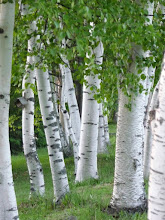In the spring, I tried starting indigo seeds in flats indoors. It did not work. In early June I found some seedlings at Twin Pond Farm's spring plant sale. The Japanese Indigo (polygorium tinctorium) plants I bought that day loved growing in our raised beds here at our bit of earth.
Last Saturday I pulled all the plants, stripped the leaves from the stems and ended up with about a pound and a half to work with.
A pound of leaves filled this large pickle jar. I covered the leaves with water, put a lid on the jar (not tight!) and set it in a large pot of water. I kept the temperature in the vat steady at around 170 degrees F for about three hours.
Over the years, I have collected several beautiful books about indigo and shibori and dying. I ended up using A Garden to Dye For by Chris McLaughlin. It's a lovely little book, with simple and easy to follow instructions.
When I got to the step in the process where I had to oxygenate the vat I felt that our decision to splurge on the farmer's style stainless steel kitchen sink was justified. Slowly pouring the the dye solution from one vessel to the next...back and forth for about 10 minutes...with plenty of room and no chance of staining...exhale with relief!
I dyed a silk scarf (the more turquoise result) and a yard of linen (the rich blue solid). I also played around with a few shibori techniques on cotton with varying results.
(I found a variety of necessary supplies for this project at Dharma Trading Co.)
(I found a variety of necessary supplies for this project at Dharma Trading Co.)
I've had a life long love of all things indigo. Growing my own plants, harvesting them and then using them to dye fabric has been on my bucket list forever. Finally accomplishing this project was so deeply satisfying for me.
There are a few coreopsis tops drying in the woodshed and the tansy is still blooming in the gardens...
How about you, dear readers...have you tried fiber dying? I'd love to hear of your results!









I'd imagine the process is very satisfying Karen. I have not tried dying fabrics with natural plant dye apart from dried tea and coffee granules. I love the aged antique effect that it gives. :)
ReplyDeleteoh yes!
Deletetea and coffee are such easy, fun ways to dye!
thanks for the reminder, simone!
So beautiful and so satisfying. You must be completely happy!!!!!!
ReplyDeletei can't wait to try some more! :-)
DeleteHow wonderful that it was your own project from beginning to end! Your results are beautiful and you must feel good every time you look at them.
ReplyDeletenow for the stitching...
Delete:-)
This is awesome, Karen! I have only painted fabric with Pebeo Setacolor transparent textile paints. I'm always fearful of chemicals, but natural dyeing looks very satisfying. Beautiful results!
ReplyDeletethanks judy!
Deleteyou do get lovely results with your textile paints, judy! xo
This is so exciting, Karen! I bought an indigo dyeing kit (with the intention of shibori dyeing some curtains) without even thinking that it's possible to do it with actual indigo grown in the garden (not sure why it never crossed my mind).
ReplyDeleteYours are gorgeous!
(and hooray for the stainless steel sink!)
thanks anne.
Deletei'll bet you could grow some indigo in your garden...
:-)
Well done! I love indigo but have never got round to dyeing let alone growing my own.
ReplyDeleteyour work with indigo is stunning, wherever it has come from!
Deletexo
how fabulous!
ReplyDeleteI would never have thought that Indigo was a plant and could grow in a garden (but, in fact, why not?). Thank you for sharing the process!
ReplyDeleteSarah
Thanks for sharing this herbs and they are good to use and also very healthy plants.
ReplyDeletemodular kitchen company in bangalore